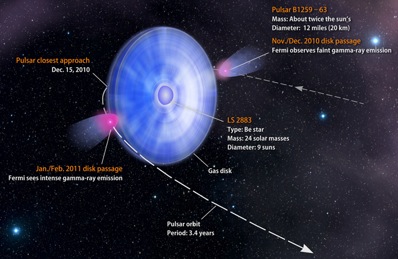
Mysterious gamma flare observed in high mass binary
by Amanda Doyle
for ASTRONOMY NOW
Posted: 05 July 2011


Astronomers using NASA’s Fermi Gamma-ray Space Telescope have detected intense and unexpected gamma radiation in an unusual high mass binary system.
The gamma ray binary, known as PSR B1259-63/LS 2883, is one of only a handful known and consists of a massive Be star which is orbited by a smaller, dense pulsar. The Be class star is 24 times the mass of the Sun and is rotating at a very high rate. A combination of mass loss and rapid rotation results in an equatorial disc of hot gas and, when the pulsar is at the point in its orbit where it is closest to its massive companion – known as periastron – it actually passes through the disc. After periastron, it also makes a second trip through the disc. This voyage through the hot gas creates gamma radiation because particles emitted from the pulsar interact with the disc.

Diagram showing the passage of the pulsar through the disc of the giant Be star around the time of closest approach. Image: NASA's Goddard Space Flight Center/Francis Reddy.
The most recent periastron of the 3.4 year orbit was on 15 December 2010 and during the pulsar’s first passage through the disc, normal levels of gamma radiation were observed with Fermi. However, the second passage created massive amounts of gamma radiation that were completely unexpected.
This is not the first time that the binary has been observed at periastron, but it is the first time that such a flare has been detected. The binary had been previously observed with EGRET on the Compton Gamma-Ray Observatory. However, EGRET only observed the binary for three weeks and was not pointed at the binary at time of the flare. “If the EGRET team had pointed the spacecraft starting a couple of weeks later they would have been able to detect the gigaelectron volt gamma-ray flare during the second passage, provided this activity occurs at the same orbital phase in each periastron passage,” explains research team leader Aous Abdo.
Another anomaly of the unforeseen gamma flare was that no unusual emission was detected in any other wavelength. The flare lasted for around seven weeks, with the most intense emission being observed on 20 and 21 January 2011, as well as on 2 February. On these days, the emission was 15 times greater than it had been for the entire six weeks of the pulsar’s first trip through the circumstellar disc. While the energy released during the flare is still negligible when compared to a gamma-ray burst, the fact that the detected gamma radiation rises from nothing when the pulsar is furthest from the Be star to an energy level in the gigaelectron volt range is very significant.
“We do have some theories/ideas that we are still working on to see if they agree with our observations,” says Abdo. “The flare we saw during the second passage could be either due to anisotropy of the gamma-ray emission, the appearance of new emission mechanism, or by an abrupt change in the physical conditions in the emission region.”
An upcoming paper using data which is in the teraelectron volt range from the HESS telescope in Namibia will hopefully fill in the blanks. The next time the pulsar and its massive companion cross paths will be in May 2014, and astronomers will be watching eagerly to see if there is a repeat performance.
|



